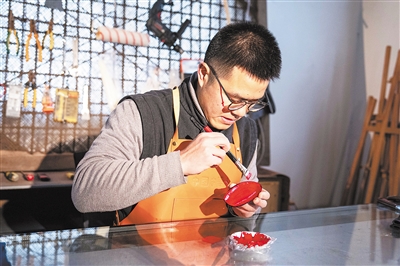
 |
| Inheritor of the intangible cultural heritage — the technique of lacquer, Hao Guanxiong, paints a tea saucer. (PHOTO:XINHUA) |
Dating back several thousand years in Chinese history, the art of lacquer is one of the oldest expressions of Asian culture. The traditional techniques of lacquer, originally used to protect wooden or woven bamboo utensils from moisture and insects, were naturally transmitted along many trade routes connecting China with its neighbors and quickly spread to other countries in Asia.
Lacquer is not only a technique of protective covering but also serves the purpose of decorating. It is often applied to the surface of furniture, bowls, cups, sculptures, musical instruments and coffins, where it could be carved, incised and inlaid to show off scenes from nature, mythology and literature.
Lacquerware refers to objects usually made of wood, bamboo and metal that have been coated with a liquid consisting of shellac or melted resin flakes dissolved in alcohol or a synthetic substance. When the liquid dries up, a hard, protective, smooth coating that remains relatively light in weight will be formed on the surface. Ancient Chinese artists often used the sap of the "lacquer tree." The resin is drained from a cut in the living tree and becomes an opaque white liquid when exposed to air.
Lacquer can be transformed into many colors by adding certain chemicals to the resin. For example, black was made by adding carbon, yellow by adding ochre, and a brilliant red by mixing in cinnabar. The surface of the lacquer-coated body after repeated painting is not only durable, but also beautiful in color.
Since lacquer is very thin, it can be used to cover almost any type of surface. The previous coat must be completely dry and highly polished before the next coat is applied, with some objects having as many as 100 such layers, illustrating that the production of lacquerware was a time-consuming and expensive business.
These lacquer techniques evolved over time, becoming exponentially more complex and resulting in an enduring art form that combined vast experience with amazing practicality, exerting a positive influence on the development of lacquer art in other countries.







